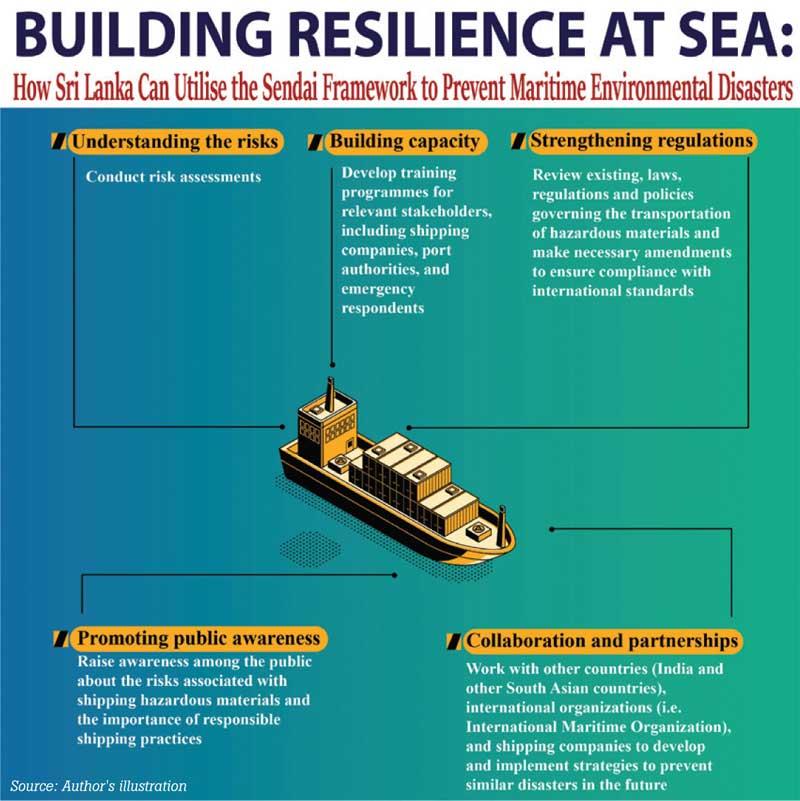04 May 2023 - {{hitsCtrl.values.hits}}

 Sri Lanka’s ecological disaster related to the MV X-Press Pearl, a container ship carrying hazardous chemicals that caught fire off its coast on 20th May 2021, is back in the news as the country attempts to claim damages.
Sri Lanka’s ecological disaster related to the MV X-Press Pearl, a container ship carrying hazardous chemicals that caught fire off its coast on 20th May 2021, is back in the news as the country attempts to claim damages.
The ecological disaster washed up tons of plastic pellets and other pollutants on the country’s beaches and harmed its marine ecosystem. It is a stark reminder of the risks associated with transporting hazardous materials and the urgent need for governments and companies to take proactive measures to prevent such disasters in the future.
This article revisits the environmental impact of the X-Press Pearl disaster and discusses how Sri Lanka can use the Sendai Framework for Disaster Risk Reduction (SFDRR) to develop strategies and policies to prevent similar disasters from happening near its shores again.
environmental and economic impacts of X-Press Pearl
The X-Press Pearl disaster has had a devastating impact on Sri Lanka’s environment and its citizens. The Marine Environment Protection Authority (MEPA) reported an oil slick of an approximate area of 0.51 km2 with a length of 4.3 km around the wreak.
According to the International Pollutants Elimination Network, the ship’s cargo included billions of plastic pellets (microplastics used to produce plastic) which have washed up on the shore, causing damage to the country’s marine ecosystem, tourism industry and its reputation as an eco-tourism destination.
According to the International Maritime Hazardous Goods Regulation (IMDG regulation), an analysis of the cargo manifest revealed that at least 81 of the 1,486 containers aboard the MV X-Press were transporting 15 distinct categories of hazardous materials, including 25 tons of nitric acid.While the full extent of the damage is yet to be determined by the MEPA, the insurance company for the ship has already compensated the Sri Lankan government to the tune of US$ 7.85 million.
Beyond the monetary valuation, the disaster has severely impacted Sri Lanka’s fishing industry, with over 20,000 fishing families and approximately 16,000 fishermen affected. Additionally, the spillage of hazardous chemicals into the sea has killed over 300 marine animals, including turtles, dolphins, and whales.
The disaster has also raised concerns about the impact of hazardous material transportation on the environment and public safety, highlighting the need for more stringent regulations, especially in densely populated areas. It also revealed institutional and capacity constraints and a lack of training in handling such emergencies, which should be addressed to prevent such disasters. This is where the SFDRR comes into play, providing a comprehensive framework to address these issues and build resilience in the face of such catastrophes.
The way forward: Preventing future maritime disasters
The X-Press Pearl disaster is a wake-up call for governments and companies worldwide to take proactive measures to prevent similar disasters in the future. Since its inception in 2015, the SFDRR has become widely recognised for managing diverse disasters worldwide.
The Sendai Framework
Even though there are various frameworks and policies related to disaster risk reduction at the national level in Sri Lanka, including the National Disaster Management Plan, they were inadequate to address the X-Press Pearl disaster timely and effectively.
Other countries use numerous measures like response and containment techniques, preparedness and planning, regulation and enforcement, international cooperation and collaboration. The SDFRR combines these individual efforts and brings them under an umbrella framework.
Hence, it offers a comprehensive framework that countries like Sri Lanka can adopt to address the challenges associated with hazardous material transportation and other maritime disaster risks.
Moreover, while the adoption of the SFDRR is novel for preventing maritime disasters,it has been widely adopted by many countries,including but not limited to Japan (climate change, Tsunami, Fukushima nuclear disaster, etc.), Australia (wildfires), and Nepal (earthquakes).Therefore, the X-Press Pearl maritime disaster emphasises the potential for harnessing the SFDRR’s wide range of applicability to prevent future similar disasters in Sri Lanka.
Understanding the risks
The first step in preventing such disasters is understanding the risks of shipping hazardous materials through Sri Lanka’s waters. Sri Lanka did not have a proper contingency plan in place to deal with a disaster of this scale.
Furthermore, the risk assessment conducted prior to granting permission for the vessel to enter Sri Lankan waters did not adequately consider the potential impact of a disaster. Thus, as mentioned in the SFDRR, Sri Lanka should conduct a risk assessment concerning the potential impact of such disasters on the environment, the economy, and public health.
Strengthening regulations
The SFDRR emphasises the need to strengthen regulations and laws to prevent disasters. For instance, the Draft National Transport Policy of 2009 highlights the safer transportation of hazardous material in all modes, yet the cabinet has not approved this.
Therefore, it is imperative that Sri Lanka reviews its existing laws and regulations, such as the National Environmental Act No. 47 of 1980, the Marine Pollution Prevention Act No. 35 of 2008, and the Dangerous Goods (Transportation) Regulationsgoverning the transportation of hazardous materials and makes necessary amendments to ensure compliance with international standards.
Building capacity
The SFDRR encourages increasing preparedness at all echelons of society. During the X-Press Pearl disaster, emergency responders lacked the necessary equipment and training to respond to the disaster effectively.Additionally, poor coordination between different agencies hampered the response effort.
To address these issues, training programmes in collaboration with the Sri Lanka Navy and MEPA could be conducted for essential stakeholders such as shipping companies, port authorities, and emergency responders. These programmes could provide them with the necessary knowledgeand skills to prevent and effectively respond to such catastrophes.
Promoting public awareness
The framework stresses the need to educate the public and raise awareness to prevent disasters. However, in the recent disaster, the lack of public awareness about the risks associated with transporting hazardous materials made it difficult to generate support for preventive measures.
Therefore, the government, private sector, non-governmental organisations and other relevant stakeholdersare responsible for informing the public about the risks of transporting hazardous commodities and the importance of adopting safe shipping practices.
Collaboration and partnerships
The framework encourages cooperation and partnership amongst all parties involved in disaster management. However, Sri Lanka did not collaborate effectively with other countries or international organisations to prevent the disaster. For example, there was no information sharing about the vessel’s previous safety record, which could have alerted Sri Lanka to potential risks. To avoid similar events in the future, Sri Lanka could collaborate with other nations (India and other South Asian countries), international organisations (such as the International Maritime Organisation), and shipping companies.
The disaster has also brought attention to the need for sustainable shipping practices, such as using alternative fuels and more eco-friendly packing materials.
Hence, by adopting the Sendai Framework, Sri Lanka can develop an effective approach to prevent similar disasters in the future through proactive measures to protect the environment, public health, and the economy.
(The writer is a Research Officer at IPS with a background in entrepreneurial agriculture. He holds a Bachelor’s in Export Agriculture from Uva Wellassa University of Sri Lanka. His research interests are environmental economics, agricultural economics, macroeconomic policy and planning, labour and migration, and poverty and development policy. He could be contacted via – [email protected])
01 Nov 2024 34 minute ago
01 Nov 2024 49 minute ago
01 Nov 2024 59 minute ago
01 Nov 2024 2 hours ago
01 Nov 2024 3 hours ago